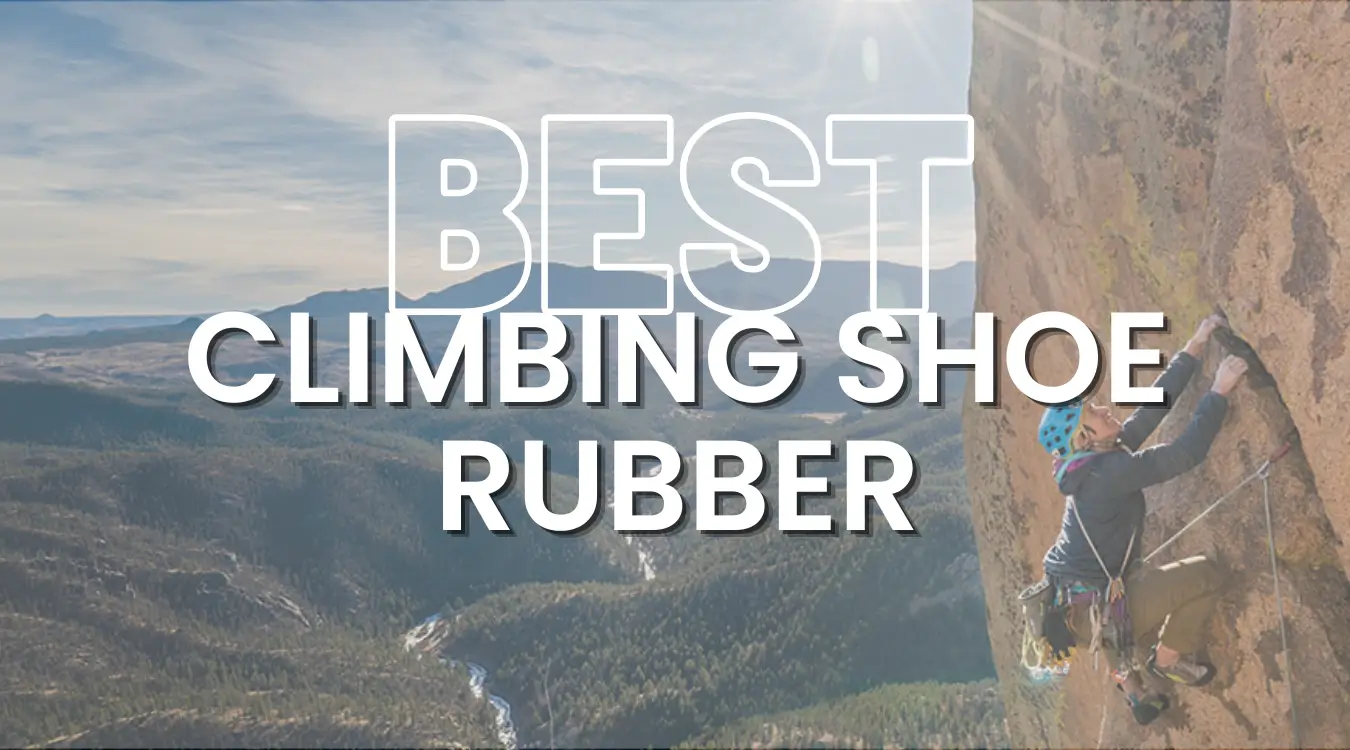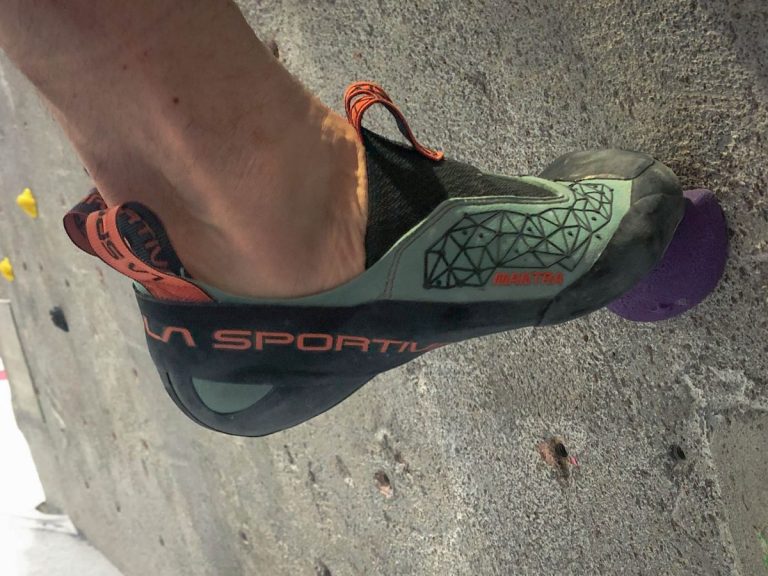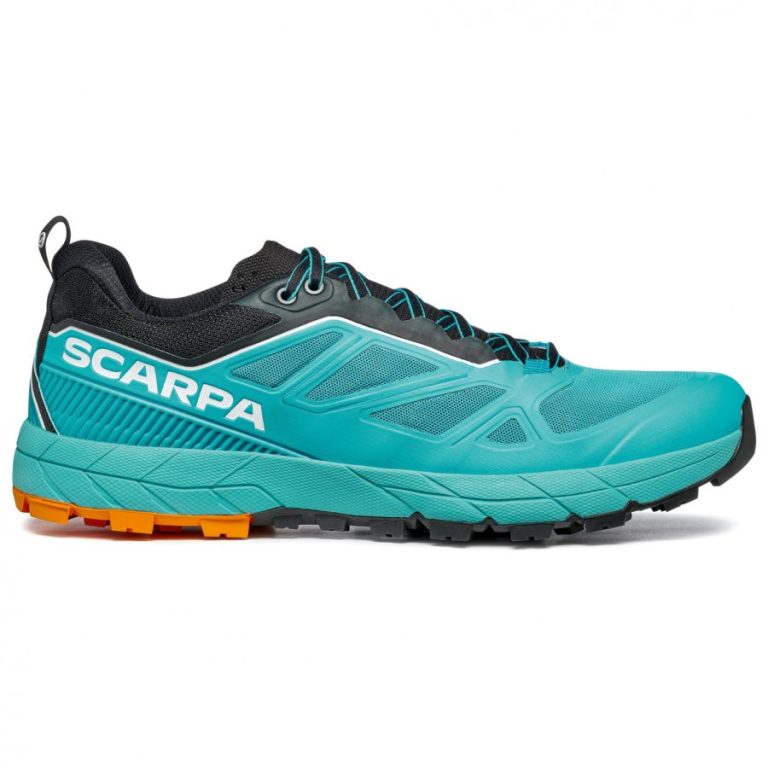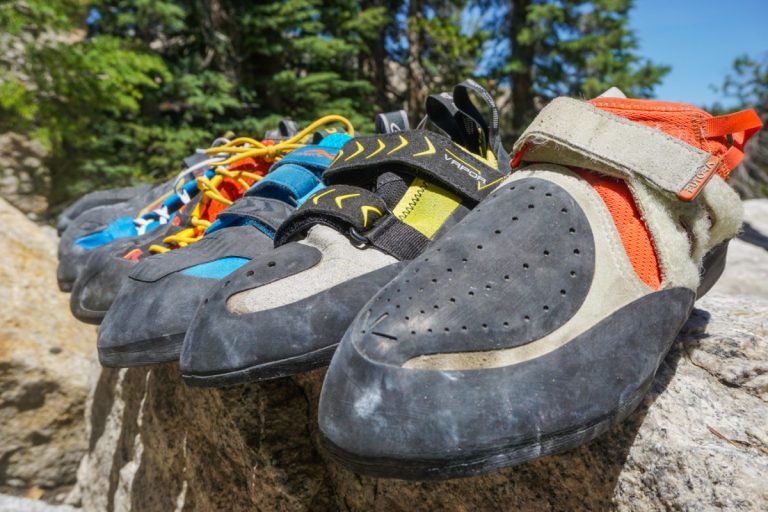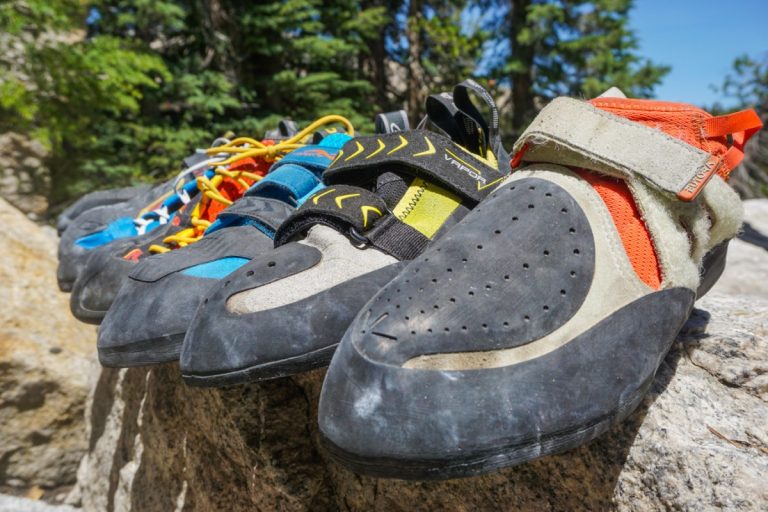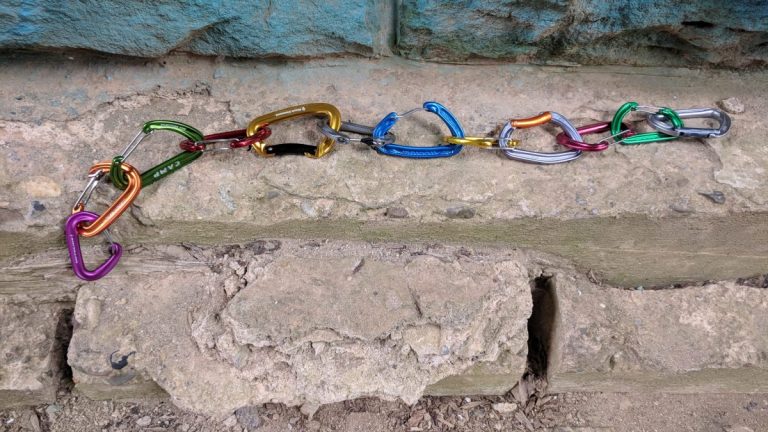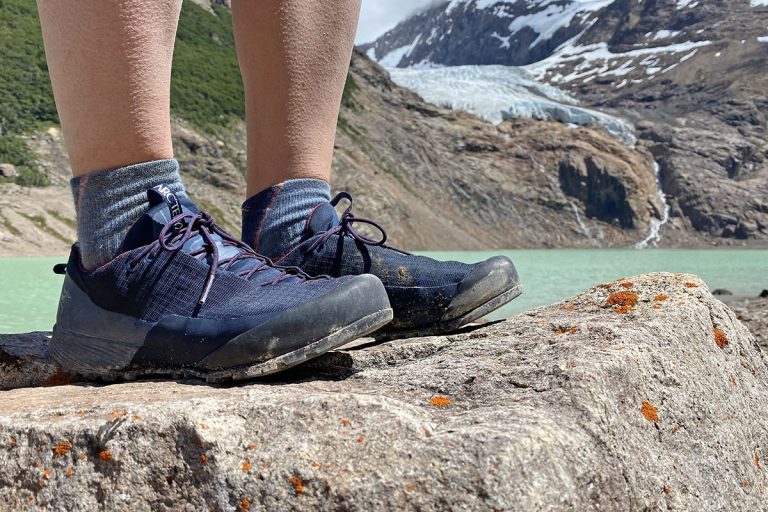The Best Climbing Shoe Rubber
Have you ever given climbing shoe rubber some thought? It would be best if you undoubtedly did so; knowing more about your rubber might even enable you to climb higher.
The rubber will significantly impact your climbing in your climbing shoes unless you are climbing without footwear. Achievements on a pro level would undoubtedly be unachievable without the proper rubber.
What Is Climbing Shoe Rubber?
The Rubber found in modern climbing shoes is manufactured from various synthetic materials and makes up many parts of the shoe, most commonly the soles and the insoles. Even while modifiers like mud and carbon black are frequently used in the rubber production technique, each brand has its own highly classified recipe to create its branded rubber.
Numerous rubber compounds created now are optimized for vertical applications. But it wasn’t always like this. So what is the difference between climbing shoes rubbers and how to choose the best one. Read on to find out.
Rubber Found In Stiff Climbing Shoes
You can stand on a stable platform thanks to the stiff climbing shoes‘ often stronger midsoles and more robust outsole rubber. The unyielding firmness of a stiff shoe due to its firm rubber is great for instilling unflinching comfort on the tiniest of supports, even while a stiff shoe will undoubtedly diminish the sensitivity with which you can “feel” the rock.
On a frantic bouldering issue, stiff shoes won’t help you at all, but the stronger rubber will certainly survive longer than a sole made of sticky rubber that is wafer thin.
Rubber Found In Soft Climbing Shoes
Soft climbing shoes are made to put as little distance as possible between you and the rock. Due to their increased sensitivity, your foot can now adapt to the form of the surface you are stepping on. Imagine these shoes to be like a pair of sticky rubber socks. They work best when applying force, smearing, hooking, or both.
There isn’t much comfort in these shoes, as opposed to their more supportive competitors, so your foot and thigh tissues must put more effort when you raise your toes. Still, for bouldering or single-pitch climbing, these shoes are better suited.
Read 5 Best Women’s Climbing Shoes
Soft vs. Stiff Rubber Comparison
Climbers often have a favored style, whether they like a soft or firm shoe. Though there may not seem to be much distinction, each provides advantages in specific circumstances. The muscles and ligaments in your toes will have to work harder when you wear soft rubber shoes and you’ll be considerably more aware of what’s going on beneath your feet if your feet have little rubber on the sole of them. Thus softer rubber needs more force from the climber to work with.
The stiffer rubber shoes are more helpful in this regard as they provide some aid to the muscles and the ligaments. Shoes with additional support and stiffness prevent foot tiredness. Because of this, stiff climbing shoes are perfect for beginning climbers whose toe flexors are still forming.
In short, softness in rubbers enables you to move your feet more exactly, essential for those sensitive foot switches on tiny grips and overhanging problems. But wearing these shoes can be tiresome. Stiff rubber gives the shoes some extra comfort, but the edging and tiny crack climbing can be difficult.
Types Of Rubber Found In Climbing Shoes
The type of rubber your shoes are made of is one of the most contentious things happening in the world of climbing footwear. The grip, longevity, and edging capability of your shoes will all be impacted by the type of rubber used.
Since high-quality rubber is essential to the production of shoes, businesses like Vibram and Five Ten have invested millions of dollars in the research and development of their proprietary rubber formulae.
Here is the top climbing rubber currently available for shoes.
Vibram Rubber
Since 1937, Vibram has ruled the mountaineering rubber industry. Vitale Brahmani founded the company with the help of a few of his pals. Brahmani spent two years innovating the processed rubber to make it more dependable even in the most difficult terrain since he believed that subpar footwear was a contributing factor in the deaths of his friends.
This rubber type can make climbing shoes sticky again. Every shoe can vary its performance based on your preferences by installing the renowned Vibram soles, but the general consensus is that it is perfect for getting the stickiness in your shoes.
1.1. Vibram XS Grip
You can climb at your peak on any solid with this perfect rubber. More than ten shoe companies, including La Sportiva, Scarpa, and Tenaya, use XS Grip, semi-stiff. Over the years, many professionals have preferred this combination.
1.2. Vibram XS Grip 2
The grip and stability of the Grip 2 are better than its predecessor’s. It’s lighter than the XS Grip and maintains a wonderful equilibrium between trimming and smearing characteristics, making it ideal for overhang climbing. Sport climbing and aggressive bouldering shoes are best suited for the XS Grip 2.
1.3. Vibram XS Edge
The XS Edge, widely regarded as one of the greatest edging rubbers, is perfect for multi-pitch and huge wall routes. Although stiffer than its competitors, the rubber is used in some of the most well-liked bouldering and general climbing shoes.
1.4. Vibram XS Flash
The XS Flash is the latest rubber to join the Vibram family. This nonmarket rubber is soft and has a high amount of friction, and it was solely formulated for indoor climbing on plastic walls.
Stealth Rubber
The famed Stealth rubber, a creation that rocked the climbing community, was the brainchild of Charles Cole. Some of the top outdoor periodicals have called the rubber the most heightened conflict rubber in the world. This can make climbing shoes more grippy, so top climbers trust them.
2.1. Stealth Mi6
It is notorious for producing some stickiest rubbers and excels in overhung ways. A rubber with extremely high friction may smear on even highly polished rock. Due to its softness, this rubber has lower durability than other types.
2.2. Stealth HF
Performance shoes made by Five Ten use Hf rubber, which has been available for more than ten years. These bouldering issues and vertical, slabby sport climbs are unique to this soft rubber. This rubber will quickly wear out because of its high friction.
2.3. Stealth C4
The C4 is the rubber in the Stealth arsenal that is most frequently utilized, and it is also the one that first won Five Ten, a cult of devoted fans. This combination, identical to the Vibram XS Grip 2, produces a more durable rubber than the previous Stealth compounds.
Trax Rubber
Don’t let the fact that Trax may not be as well-known as Vibram or Stealth cause you to believe that this rubber is inferior. Some geniuses have worn this rubber, because with this rubber type, you won’t have to worry about the climbing shoes losing grip
3.1. Trax SAS
Most Evolv shoes utilize this semi-stiff Trax rubber, the most common type. Trax-SAS is a fantastic all-purpose rubber because it balances friction and toughness, performs on rock and plastic holds, and is built to do so.
3.2. Trax XE
This extremely strong rubber was created with edges in view.
This rubber, which can be found on their ultra-performance shoes, is undoubtedly at home on stone and concrete walls and is unquestionably one of the most enduring rubbers in the industry.
3.3. Trax GT
The GT rubber is the newest member of the Trax family, developed in the Evolv labs specifically for glass and gym climbing. And not all of their shoes are made of this durable, non-marking substance.
evolv trax xt5
The Evolv Trax XT5 is a unique rubber formulation used in the soles of performance shoes by Evolv. Known for its exceptional friction and durability, it’s a must-have for those seeking to level up their outdoor game.
Features of Evolv Trax XT5
High Traction Rubber
Evolv Trax XT5 is renowned for its high traction rubber. Can you imagine a gecko climbing a wall? That’s the kind of grip we’re talking about here. This feature ensures that you can trust your shoes to keep you secure, whether you’re rock climbing or hiking rough terrains.
Durability
The Evolv Trax XT5 is built to last. Its high-quality rubber formulation means it can withstand extreme conditions and repeated use. It’s like the Hercules of shoe soles!
Versatility
From climbing shoes to approach shoes, the Evolv Trax XT5 is versatile. It’s like a Swiss army knife, ready to adapt to your adventurous needs.
FriXion Rubber
Numerous performance shoes from La Sportiva are made with Vibram rubber. However, their FriXion rubber is frequently used in their more cheap models. Only two of the five substances that contain La Sportiva’s FriXion range are now used for climbing shoes; the other three have been used for their climbing and sneakers.
4.1. FriXion Black
It’s utilized on affordable footwear like the Tarantulace and the Oxygym. An “extremely adhesive productivity solution” prioritizes effectiveness over stability. On plastic, FriXion black typically outperforms rock.
4.2. FriXion White
A pro-strong rubber made specifically for indoor climbing is called FriXion White. There are currently no La Sportiva climbing shoes that include FriXion White as standard, but we are interested to see what the company will create in the future with this rubber.
What Is The Best Climbing Shoe Rubber? Our Take
Bouldering season is still here. There is no need to search more if you want to stick. The most popular rubbers available today are examined below and how they can increase your strength.
- Vibram XS
- Anasazi LV Pro
- Niad Lace
- FriXion White
- Trax XE
FAQs
What purpose do stiff climbing shoes serve?
These shoes build a barrier on top of a footing rather than conforming to its contour so the main factor considered while choosing a climbing shoe is giving support. Your shoes will wear off far more slowly due to less stress on your soft tissue.
Does the rubber in climbing shoes wear out with time?
Likely, you will eventually wear out the rubber in your climbing shoes if you put them through their paces. How much and what you are climbing determines how long it bears for the rubber on your shoes to get old.
Final Thoughts
Ultimately, we have concluded that various climbing shoe rubbers are made for various tasks and terrain: surface, weight, and temperature all impact the rubber’s capacity and efficiency. Furthermore, they also vary according to your definition of excellence. The final choice of rubber thus rests on your own shoulders. Try various types and see which ones fit you best, and stick with those. Happy perfect climbing!
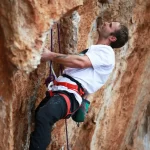
Leah Leonard
Leah Leonard is a renowned author and seasoned climber, best known for her captivating book, “Perfect Climbing.” Her experiences scaling the world’s most formidable peaks have not only shaped her adventurous spirit but also lend a unique authenticity to her compelling narratives.
